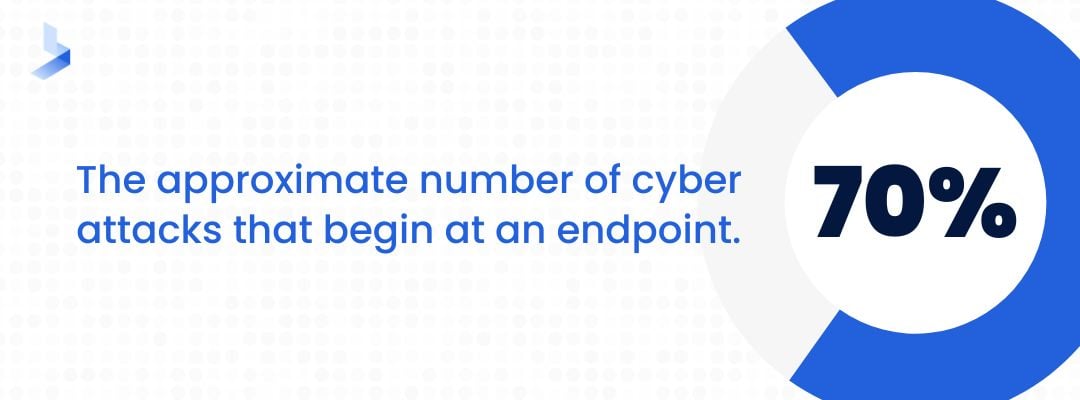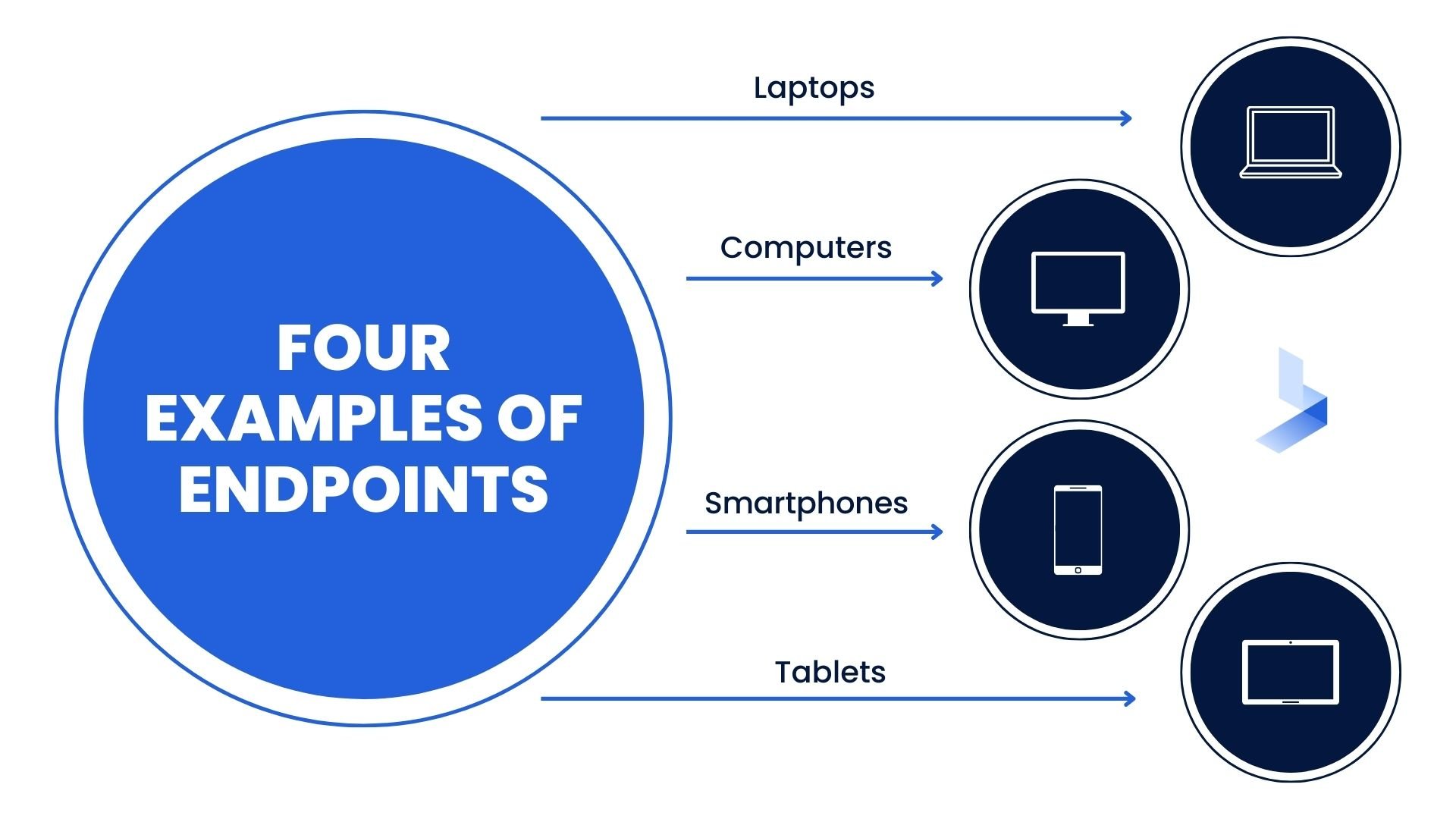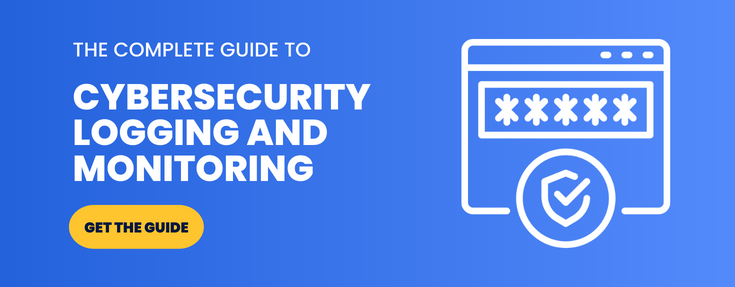Endpoint Security: Protecting Your Network from the Inside Out

 By
Emily Miller
·
7 minute read
By
Emily Miller
·
7 minute read
With nearly 70% of all cyber attacks beginning at an endpoint, it’s no surprise that endpoint security is an important topic for businesses. An endpoint, which refers to any device that can access a network, includes computers, smartphones, tablets, or any connected device. As these devices become more commonplace in business networks, organizations need to take the steps necessary to ensure these endpoints are secure. In this blog, we will explore the importance of endpoint security and discuss some of the best practices for implementing it in your organization.

What is endpoint security?
Endpoint security is a term used to describe the practice of securing devices on a network, such as laptops, smartphones, and tablets, against threats and vulnerabilities. Endpoint security typically uses a combination of software and hardware solutions, such as antivirus and firewalls, to protect these devices from malware, unauthorized access, and other potential security threats. This is important because, as mentioned, endpoint devices are often the first point of entry for hackers and other malicious actors.
By implementing endpoint security measures, you can help prevent unauthorized access to your network and protect against cyber threats such as viruses, malware, and ransomware. Additionally, endpoint security can help prevent data breaches and ensure compliance with regulatory requirements such as HIPAA and GDPR.

Best Practices for Endpoint Security
Endpoint security is a crucial component for protecting your organization's network and data from cyber threats. Having a robust endpoint security strategy is essential to prevent attacks and minimize the impact of any potential breaches. A few best practices a business can follow to strengthen their endpoint posture include:
- Implementing strong authentication and access controls to ensure only authorized users can access sensitive systems and data.
- Regularly updating and patching software to fix known vulnerabilities and prevent exploits.
- Using antivirus and anti-malware software to detect and remove malicious software from endpoints.
- Monitoring endpoints for unusual or suspicious activity, and implementing intrusion detection and prevention systems to identify and block potential threats.
- Implementing encryption to protect data in transit and at rest.
- Providing regular security training and awareness programs to educate employees about best practices and the latest security threats.
Layering Your Defenses
One of the most important defense methods in endpoint security is the use of a layered approach. By using multiple layers of defense, an organization can cover a wide range of threats to better defend against both known and unknown threats. This is because each layer of defense serves a specific purpose, and works in conjunction with the other layers to provide comprehensive protection.
For example, one layer may focus on antivirus protection, while another layer may focus on firewalls or intrusion prevention systems. By using a combination of these different layers, an organization can significantly reduce the risk of a successful attack on its endpoint devices.
Additionally, a layered approach allows an organization to quickly respond to new threats, as it can easily add new layers of protection as needed. This flexibility is important because the threat landscape is constantly evolving, and organizations must be able to adapt to these changes in order to effectively protect their systems.
Implementing a Zero Trust Approach
Another best practice to use in endpoint security is to implement a zero-trust model. This approach assumes that every user, device, and network connection is untrusted and must be verified before being granted access to sensitive resources. This method protects against a wide range of threats, including malicious insiders, advanced persistent threats, and other forms of cyber attacks.
By implementing a zero-trust security model, organizations can better defend against these threats and reduce the likelihood of a successful attack. Additionally, because a zero-trust security model focuses on verifying the identity and trustworthiness of users and devices, it can help organizations maintain compliance with various security regulations and standards.
To implement the zero-trust model, you should follow these eight steps:
Step 1: Identify and prioritize assets
The first step in implementing a zero-trust model is to determine which assets are most critical to the organization. This list should include which assets should receive priority order and may include servers, databases, applications, and other systems.
Step 2: Understand the current security posture
After creating the priority list, the next step is to conduct a thorough assessment of the current security posture. An assessment can be conducted by running a vulnerability scan to identify any potential weak points, analyzing user and device access, and including user permissions and access control lists, and checking the system logs for unusual or suspicious activities.
Step 3: Define security policies and procedures
Once the current security posture has been assessed, organizations must then define the security policies and procedures that will be used to protect their assets. Policies should be tailored to the organization and should include:
- Strong authentication and access control measures
- Regular vulnerability scanning
- Strict user privilege management
- Intrusion detection and prevention systems
- Data encryption
- Anti-malware protection
- Audit and audit logging
Step 4: Implement the policies
After the policies and procedures have been defined, the organization must then implement them. This involves updating software and systems with the latest security patches, configuring firewalls and identifying user permissions.
Step 3: Define the trust boundaries
Next, you should determine the boundaries of the network and define the trust levels of different assets and users. This could involve segmenting the network into smaller, more secure zones and assigning different trust levels to different assets and users.
Step 4: Implement multi-factor authentication
Use multi-factor authentication (MFA) for all user accounts to add an extra layer of security. This could involve using a combination of something the user knows (such as a password), something the user has (such as a security token), and something the user is (such as biometric data).
Step 5: Use a least privilege model
Implement a least privilege model for user accounts, which means granting the minimum level of access required to perform specific tasks. This helps to prevent unauthorized access to sensitive systems and data.
Step 6: Monitor and audit access
Monitor and audit access to systems and data to detect and prevent unauthorized access. This could involve using tools such as log analysis, network monitoring, and intrusion detection systems.
Step 7: Implement security controls at every point
Implement security controls at every point in the network, including at the endpoint, network perimeter, and within the network itself. This could involve using technologies such as firewalls, virtual private networks (VPNs), and encryption.
Step 8: Continuously reassess and update the security posture
Regularly reassess the security posture and update security controls and policies as needed to ensure the organization remains secure.
Implementing security orchestration and automation
In addition to a zero-trust approach, you may also want to consider the implementation of security orchestration and automation. This is considered another best practice for endpoint security because it can help organizations improve their security posture by streamlining and automating various security processes and tasks.
These tasks may include detecting and responding to security threats, collecting and analyzing security logs, and managing security policies and configurations. By automating these processes, organizations can reduce the likelihood of human error and improve their ability to respond quickly and effectively to security incidents.
Additionally, security orchestration and automation can help organizations save time and resources by automating routine tasks, freeing up security teams to focus on more complex and high-priority issues.
To get started with security orchestration and automation, you should follow these six steps:
Step 1: Identify and prioritize security threats
The first step in implementing security orchestration and automation is to identify the types of threats that your organization is most likely to face. This may involve analyzing data from security systems, such as intrusion detection and prevention systems, to identify patterns of malicious activity.
Step 2: Define security policies and procedures
Once you have identified the types of threats that your organization is most likely to face, you should define the policies and procedures that will be used to address these threats. This may include setting up incident response plans, defining access controls, and establishing protocols for handling data breaches.
Step 3: Choose and implement security tools
To automate and orchestrate your organization's security efforts, you will need to select and implement a range of security tools. These may include security information and event management (SIEM) systems, vulnerability management tools, and identity and access management (IAM) systems.
Step 4: Integrate security tools and systems
Once you have chosen and implemented the necessary security tools, you will need to integrate them into your organization's overall security infrastructure. This may involve configuring APIs and integrating security systems with one another to enable automation and orchestration.
Step 5: Test and refine the security orchestration and automation system
After implementing your security orchestration and automation system, it is important to test and refine it to ensure that it is functioning as intended. This may involve running simulated attacks and monitoring the system's response to identify any areas for improvement.
Step 6: Train and educate employees
To ensure that your security orchestration and automation system is effective, it is important to train and educate your employees on how to use the system and follow security protocols. This may involve providing regular training sessions and communicating updates and changes to security policies and procedures.
The future of endpoint security
In the future, endpoint security is likely to become even more important as more devices become connected to the internet and the number of potential entry points for cyber attackers increases. In fact, Data Bridge Market Research forecasts the growth of the endpoint security industry to reach $27.89 billion by 2029.
One trend that is likely to continue is the use of artificial intelligence (AI) and machine learning to help improve endpoint security. These technologies can be used to detect and block threats in real-time, and can also help security teams to respond quickly to any security incidents that do occur.
Another trend that is likely to emerge is the use of biometric authentication for endpoint security. This could include the use of fingerprints, facial recognition, or even iris scans to verify the identity of users and ensure that only authorized individuals are able to access sensitive information.
Overall, the future of endpoint security is likely to involve a combination of advanced technologies and more robust security protocols to help protect against increasingly sophisticated cyber threats.
It's also important to have a comprehensive incident response plan in place to quickly and effectively respond to security breaches and other security incidents. This should include clear roles and responsibilities, communication protocols, and steps for remediation and recovery.
Endpoint Security Solutions
Endpoint security is and will continue to be a crucial component of maintaining the overall security of an organization's network and data. By implementing robust endpoint protection measures and following best practices, organizations can protect themselves from costly data breaches and other cyber threats. It is important to regularly assess and update your endpoint security measures to ensure that they are effective in protecting against the latest threats. By taking the time to properly implement and maintain endpoint security, organizations can protect their sensitive information and keep their networks running smoothly.
If you're concerned about the security of your organization's network and data, we recommend using a comprehensive approach such as extended detection and response. XDR security gives you a 360-degree view across your entire network, including endpoints. BitLyft AIR®, our unique offering works to collect, monitor, and correlate log data 24/7. This gives you the real-time threat detection and analysis needed to quickly respond to any potential security incidents. Ready to see how it works? Contact us today to get started.


